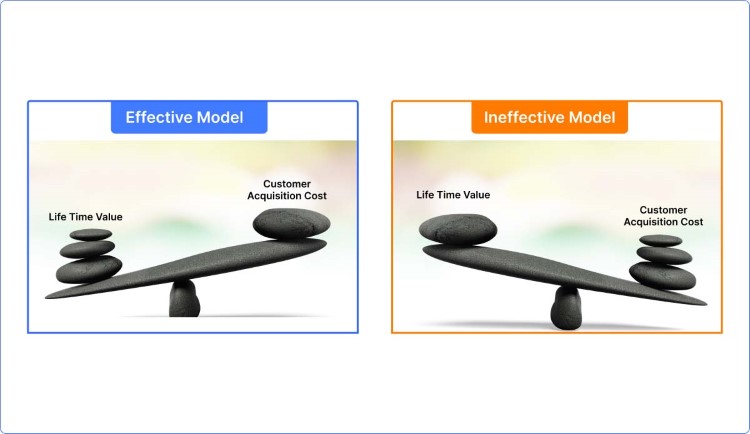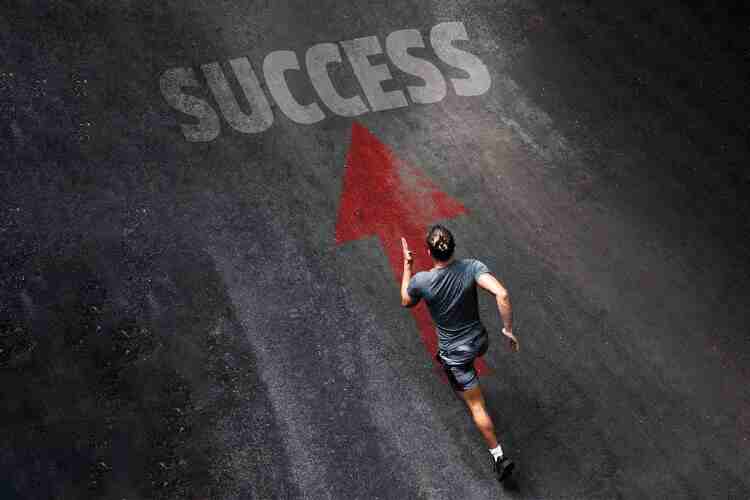Customer Acquisition Cost (CAC) goes beyond being a trendy term; it stands as a vital customer metric to monitor in the context of modern hybrid business models. Let’s think of a scenario where your company has recently appointed an influencer to endorse your products on social media, and you have good results.
Can you provide a clear and objective definition of what “good” means in this context? Can you precisely measure the responses and gauge the return on investment (ROI) for this marketing campaign? Can you obtain a specific figure to comprehend the exact expenditure incurred in convincing someone to acquire your services? Here you need to calculate the CAC.
Let me help you out here! In this article, I’ll break down what CAC is, how to calculate it, and ways to make it better. So, keep reading!
Understanding CAC: The Definition
CAC (Customer Acquisition Cost) is a business metric that calculates the expenses of bringing in new customers for your organization.
A company’s CAC represents the cumulative expenses related to sales and marketing efforts required to acquire a new customer within a specified timeframe. This metric holds significant importance in assessing your company’s profitability as it reflects the money invested in customer acquisition against the actual number of customers acquired. When you evaluate CAC alongside LTV (lifetime value), you gain an even clearer insight into your future profitability, especially as customers remain with your company over an extended period.
Customer Acquisition Cost (CAC) adds the time and financial resources allocated to activities such as research, marketing, and advertising. This comprehensive approach empowers brands to determine the Return on Investment (ROI) associated with acquiring new customers. The derived metrics enable you to adopt a data-driven approach in deciding the optimal amount of resources to allocate for the acquisition of specific customers.
Why CAC Matters?
CAC serves as an indicator of the effectiveness of your marketing and sales campaign performance. Your teams invest significant time, energy, and resources in their quest to acquire new customers and enhance customer retention. CAC stands out as a pivotal key performance metric that your business needs to monitor closely in order to understand the efficiency of your campaigns.
Once you grasp the expenses associated with acquiring a customer, you can initiate strategies to minimize those costs, thereby enhancing your return on investment (ROI). For instance, if you aim to create a sales email with a high conversion rate, you can assess the campaign’s efficiency and conduct A/B testing on various elements to pinpoint opportunities for cost reduction.
Retaining customers comes at a lower cost compared to acquiring new ones. Therefore, while Customer Acquisition Cost (CAC) is an important metric, it’s essential to consider other factors that can impact your overall profitability, such as customer retention.
How to Calculate CAC?
To figure out CAC, you just add up how much you spent on marketing and sales to get new customers and divide that by the number of new customers you got. This is usually done for a set time, like a year or a quarter.
Let me give you an example here. If a company invested $2,000 in marketing and sales over a year and managed to gain 2,000 new customers, the CAC would be $1. This is calculated by dividing the $2,000 by the 2,000 customers, resulting in $1 per customer.
The customer acquisition cost calculation is quite simple, but the process of tallying up total expenses can involve numerous factors. This includes accounting for the expenses associated with various marketing strategies and the salaries of staff involved.
Breaking Down CAC: Understanding the Components of Cost
If you’re uncertain about how to determine your “sales and marketing expenses,” take the following costs into consideration for this metric.
-
Advertising Expenditure
It refers to the funds your business has allocated for advertising. Advertising proves effective for certain businesses in drawing in new customers. To ensure the success of ads, your campaigns must align with the preferences of your intended audience. If you’re uncertain about the performance of a marketing campaign, you can assess its effectiveness by dividing the revenue generated through the advertisement by the campaign’s total expenditure.
-
Salary of Employees
Your hard-working employees are an investment that pays off. Therefore, if you find the cost of their salaries to be high, carefully consider your approach. There are alternative ways to trim salary expenses without resorting to pay cuts or layoffs. For instance, integrating chatbots and marketing automation into your workflow can enhance your team’s efficiency and boost your company’s productivity.
-
Creative Expenditure
Creative costs consist of the expenditures associated with content creation. These expenses may include the funds used to enlist talent for company promotion or even the budget allocated for team meeting lunches. All of these financial outlays contribute to the overall production of content.
-
Technology Expenses
It includes the technologies utilized by your marketing and sales teams. For instance, if you’ve acquired a reporting tool that monitors the status of your active deals, that falls under the category of technical expenses.
-
Publishing Expenditure
These are the expenses incurred to launch your marketing campaign for public consumption. These may include payments for TV airtime, sponsored social media ads, or placements in prime newspapers or magazines.
-
Production Expenses
Production costs encompass the expenses linked to the actual creation of content. For instance, if you’re producing a video, you’ll need to budget for purchasing a camera, setting up a filming location, and video editing, among other related costs. These expenditures may increase, particularly if you’re outsourcing the content production to a third party.
-
Inventory Maintenance
Regardless of whether you run a SaaS (Software as a Service) business or deal in physical products, you’ll incur expenses to ensure the upkeep and enhancement of your offerings. For businesses handling tangible goods, these costs might involve utility bills and storage fees at a facility. However, if you’re in the software industry, these expenses are the funds allocated for updates and patches aimed at enhancing the user experience.
LTV to CAC Ratio: Maximizing Your Business Growth
Organizations look into the LTV(Lifetime Value) to CAC(Customer Acquisition Cost) ratio (LTV: CAC) as a compass for their expenditures in marketing, sales, and customer service. LTV: CAC provides a concise overview of the value of customers in relation to the resources invested by the business to acquire them.
Companies should aim for a balance in this ratio to make the most of their money. It’s best if it takes about a year to cover the cost of getting a customer, and the LTV: CAC should ideally be at 3:1. In simpler terms, the worth of your customers should be three times the expense of acquiring them.
If the ratio is closer to 1:1, it implies that you’re investing as much money in acquiring new customers as they’re spending on your products. On the other hand, if the ratio is higher, say 5:1, it suggests that you may not be dedicating sufficient resources to sales and marketing, potentially leading to missed opportunities for generating new leads.
Now, you might be curious to know how to achieve that perfect ratio in your CAC metric. The answer to that question can vary depending on your industry. To provide your team with clearer goals to aim for, in the next part of this article I have listed some of the best strategies you can employ to achieve that 3:1 ratio.
The Path to Better CAC: Strategies for Success
You have to understand that the customer acquisition funnel encompasses the complete journey from lead generation to lead acquisition and finally to lead conversion. Enhancing your CAC necessitates a robust customer journey strategy fine-tuned to be cost-effective and channel-efficient, spanning from the funnel’s beginning to its conclusion.
There are several methods to enhance your CAC metric in order to move closer to achieving that 3:1 LTV: CAC ratio. Here are some great techniques to consider:
1. Add Value to Your Products
The way users perceive the value of your products and services is a matter of personal perspective, and replicating features used by other companies is not a good idea at all. Your strategy for retaining customers relies on your capacity to understand what truly motivates your customers to purchase your products.
The most effective approach involves emphasizing the significance of excellent customer service across your entire organization. Moreover, you can also talk to customers through surveys or emails to understand what they really want. Additionally, studying data like customer retention rates and subjective feedback from customer reviews can offer valuable insights. Based on all this information, you can enhance your product offerings to attract new customers in a much lesser CAC.
Pro Tips
- Customize your products and services to align with each customer’s preferences and needs.
- Create distinctive and valuable features that differentiate your products from competitors.
- Supply customers with resources, tutorials, and support to optimize their product usage.
- Provide pricing that is both reasonable and competitive, reflecting the perceived product value.
- Maintain transparent communication with customers regarding product updates, modifications, and enhancements.
2. Increase the Rate of Converting Leads
Google Analytics enables you to monitor factors such as the frequency of shopping cart abandonment. If you notice high abandonment rates, consider optimizing webpage loading times and enhancing the visual appeal of your landing pages to encourage visitors to explore further. It’s essential to assess the mobile friendliness of your site and the ease of the checkout process for buyers. Improving these aspects will enhance the customer experience and, in turn, boost conversion rates.
Some More Tips:
- Prioritize lead quality by confirming their genuine interest in your products or services.
- Explore various marketing strategies, messaging, and landing page options to pinpoint what connects best with your target audience.
- Create informative and engaging content that helps leads on their journey.
- Opt for multiple marketing channels like email, social media, and content marketing to engage leads at different stages.
- Give a clear and persuasive call to action.
3. Incorporate a CRM Platform
A CRM platform helps in monitoring new customers, their progression through the marketing funnel, purchase history, including time and geographic location, loyalty program involvement, etc. Additionally, it facilitates the management of email lists and campaigns, such as brand promotions, email marketing, and different campaigns that periodically deliver engaging content via email.
Pro Tips:
- Simplify your sales process by managing leads and opportunities, guaranteeing a more seamless transition from leads to customers.
- Categorize the customer base according to their demographics, behavior, etc. to enhance your marketing strategies.
- Enhance customer support by efficiently monitoring and resolving customer queries and concerns in real time.
- Examine CRM data to spot trends, customer behavior trends, and chances for enhancing marketing and customer retention techniques.
- Verify that your CRM seamlessly integrates with other business tools and systems to optimize your operations.
4. Establish a Customer Referral Initiative
When one of your customers refers a warm lead from his network who’s already interested in your offerings, his individual CAC is effectively $0 if that lead converts. These “cost-free” customers can gradually reduce your CAC, so it’s essential to establish a customer referral program that entices your customers to participate willingly.
Pro Tips:
- Offer enticing rewards to motivate your current customers to refer their friends and family.
- Effectively convey the details of your referral program to your customers, outlining its advantages and how it works.
- Simplify the referral process, making it effortless for customers to refer others.
- Employ a tracking system to monitor referrals and reward customers when their referred leads become paying customers.
- Take regular customer feedback to enhance your referral program based on their input and recommendations.
5. Invest in Resources for Better Conversion Rates
Ensure that the process for visitors to become leads or for leads to become your customers and complete purchases on your website is easy and simple. Create a mobile-optimized website, evaluate your content to enhance clarity, and establish an automated sales process that allows visitors to make purchases from your platform around the clock.
Pro tips:
- Make sure that your website looks professional and user-friendly, facilitating better visitor navigation and conversions.
- Perform A/B testing on website components and content to determine what connects most effectively with your audience.
- Streamline the checkout process to minimize obstacles and prompt successful purchases.
- Utilize distinct and persuasive CTAs that direct visitors towards conversion actions.
- Evaluate customer data and behavior to pinpoint opportunities for enhancing conversion rates.
6. Add Testimonials
Don’t ignore the importance of testimonials. When your satisfied customers provide positive feedback regarding your product offerings through social media, email, or reviews, make sure to highlight some of these comments on your website. Displaying endorsements from those who appreciate your product or service can effectively address common customer apprehensions.
Pro Tips:
- Give testimonials a prime spot on your website, especially on important pages such as the homepage, product/service pages, and checkout.
- Improve the visual appeal of testimonials by incorporating images or videos featuring satisfied customers.
- Take testimonials to the next level by transforming some into comprehensive case studies.
- Promptly encourage customers to share their testimonials, reviews, or even generate user-created content.
Explaining CAC By Industry: Real-Life Examples
Understanding the concept of Customer Acquisition Cost (CAC) and its proper calculation is really important for businesses striving to refine their marketing strategies. Here I have given some of the examples that demonstrate the methodologies companies from different industries employ to calculate CAC and navigate the expenses associated with acquiring new customers. Let’s delve into each example to gain a comprehensive understanding!
1. Software Company
Suppose a CRM software enterprise invests $20,000 in a marketing campaign. Following the campaign, the company identified that 1,000 new customers have subscribed to their service. Annually, the company anticipates incurring an additional $40,000 in other technical and production expenses associated with these new customers.
The Customer Acquisition Cost (CAC) for this software company is calculated as follows:
CAC = ($20,000 + $40,000) ÷ 1,000 = $60,000 ÷ 1,000 = $60
This means that the company spent $60 to get a new customer.
2. A Real Estate Brand
Consider a real estate enterprise that mainly deals with selling flats, and allocates $10,000 for marketing and $20,000 for sales efforts. Following the execution of their advertising campaigns, the company successfully gained 50 new customers.
So, let’s calculate their total CAC:
CAC = ($10,000 + $20,000) ÷ 50 = $30,000 ÷ 50 = $600
That means, the company spent 600$ to acquire each new customer.
3. The Consumer Goods Brand
Imagine a consumer goods company operating on a limited budget, allocating $6,000 to sales and $4,000 to marketing, resulting in the acquisition of 200 new customers. In this scenario, the company’s Customer Acquisition Cost (CAC) is computed as follows:
CAC = ($6,000 + $4,000) ÷ 200 = $10,000 ÷ 200 = $50
This implies that the company invested $50 to obtain each new customer.
Smart Solutions for Customer Acquisition – Powered by REVE Chat
The combination of CAC and CLV serves as a potent tool for evaluating ROI and achieving marketing objectives. In the short term, it provides a measurable evaluation of the cost per customer, while in the long term, it offers insights into the revenue generated from each conversion. REVE Chat proves to be a great help in this context, functioning as an effective customer engagement tool to enhance conversions and reduce your CAC.
REVE Chat stands as an omnichannel customer engagement platform that enables you to provide real-time support to your customers through diverse channels, such as your website, mobile apps, and various social media platforms like Facebook, Viber, Instagram, Telegram, and WhatsApp.
Additionally, the platform incorporates REVE Chatbot, an AI-driven customer engagement solution. This not only streamlines your business processes, especially in customer service but also ensures continuous customer support beyond your standard working hours. Undoubtedly, it aids in providing tailored assistance to potential customers and brings in a substantial number of new clients.
Why don’t you give it a shot? Explore the distinctive features of REVE Chat with a complimentary 14-day trial. Don’t wait; SIGN UP today!







